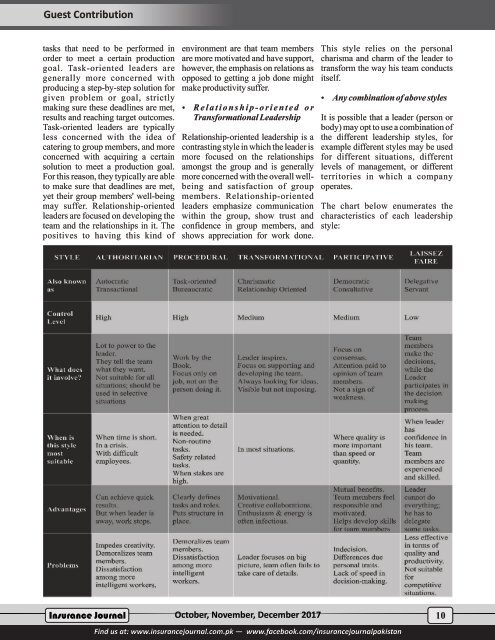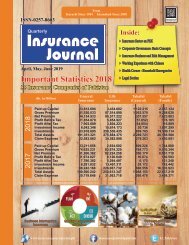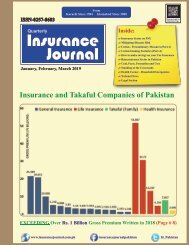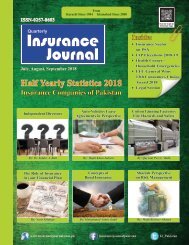Insurance Journal (4th Quarter 2017)
You also want an ePaper? Increase the reach of your titles
YUMPU automatically turns print PDFs into web optimized ePapers that Google loves.
Guest Contribution<br />
tasks that need to be performed in<br />
order to meet a certain production<br />
goal. Task-oriented leaders are<br />
generally more concerned with<br />
producing a step-by-step solution for<br />
given problem or goal, strictly<br />
making sure these deadlines are met,<br />
results and reaching target outcomes.<br />
Task-oriented leaders are typically<br />
less concerned with the idea of<br />
catering to group members, and more<br />
concerned with acquiring a certain<br />
solution to meet a production goal.<br />
For this reason, they typically are able<br />
to make sure that deadlines are met,<br />
yet their group members' well-being<br />
may suffer. Relationship-oriented<br />
leaders are focused on developing the<br />
team and the relationships in it. The<br />
positives to having this kind of<br />
environment are that team members<br />
are more motivated and have support,<br />
however, the emphasis on relations as<br />
opposed to getting a job done might<br />
make productivity suffer.<br />
Ÿ<br />
R e l a t i o n s h i p - o r i e n t e d o r<br />
Transformational Leadership<br />
Relationship-oriented leadership is a<br />
contrasting style in which the leader is<br />
more focused on the relationships<br />
amongst the group and is generally<br />
more concerned with the overall wellbeing<br />
and satisfaction of group<br />
members. Relationship-oriented<br />
leaders emphasize communication<br />
within the group, show trust and<br />
confidence in group members, and<br />
shows appreciation for work done.<br />
This style relies on the personal<br />
charisma and charm of the leader to<br />
transform the way his team conducts<br />
itself.<br />
Ÿ<br />
Any combination of above styles<br />
It is possible that a leader (person or<br />
body) may opt to use a combination of<br />
the different leadership styles, for<br />
example different styles may be used<br />
for different situations, different<br />
levels of management, or different<br />
territories in which a company<br />
operates.<br />
The chart below enumerates the<br />
characteristics of each leadership<br />
style:<br />
<strong>Insurance</strong> <strong>Journal</strong> October, November, December <strong>2017</strong><br />
10<br />
Find us at: www.insurancejournal.com.pk — www.facebook.com/insurancejournalpakistan


















